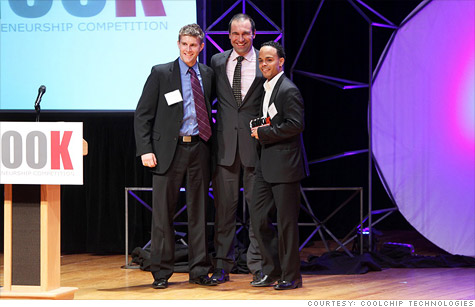Search News

CoolChip co-founders Steven Stoddard, left and, William Sanchez, right, impressed the judges at MIT entrepreneurship competitions.
(CNNMoney) -- Every time you watch a Lady Gaga video on YouTube or get driving directions on Google Maps, a server farm somewhere is heating up. The more you do online and the faster it happens, the more energy it takes. Data centers now consume about 2% to 3% of all electricity generated annually in the U.S. That's the same amount it takes to power the state of New York -- and demand keeps climbing.
But most of the energy data centers use doesn't go directly to running servers. Instead, it's dedicated to keeping them cool: Temperatures above 75 degrees Fahrenheit can cause the chips inside the servers to malfunction.
Despite decades of advances in computer technology, the most common cooling strategy for servers hasn't changed much. A radiator sits on top of the server's chips, drawing up heat that gets dispersed by a simple fan that branches off to the side. This is an old method -- and an inefficient one -- which means data centers still have to blast their air conditioning systems day and night just to keep servers working.
That's where CoolChip Technologies comes in. The three-person company in Somerville, Mass., launched last fall and is developing two new high-efficiency heat sinks that could reduce cooling costs in data centers by up to 40%, according to 28-year-old chief executive and MIT grad William Sanchez. In May, CoolChip won MIT's Clean Energy Prize, netting about $230,000 to fund its efforts.
"Ironically, right after we incorporated we had to move the research out of MIT -- to my garage," Sanchez says.
Mechanical fans have been around since the 17th century, and they're seldom improved upon. But the first of CoolChip's two heat sink models uses a circular aluminum fan that seems straight out of the space age. Imagine something that looks like a tiny flying saucer -- a disc with fan blades -- floating over the heat-conducting radiator that sits above the chips.
"We manipulated the fluid dynamics to get it to lift and hover," Sanchez says. "The spinning motion keeps it aloft."
Sanchez plans to bring his initial heat sinks to market by late next year and to sell them at a retail price of $30. Ultimately, he hopes to offer a more advanced version -- a combination of the current model and another design, one devised by mechanical engineering researchers at MIT and funded with about $2.4 million from DARPA, the Pentagon's research arm.
Sanchez and CoolChip co-founder Steven Stoddard, 26, met as engineering grad students at MIT, where they learned about technologies the school was developing with the hope that entrepreneurial students would commercialize them. That project portfolio included the DARPA-funded heat sink.
CoolChip licensed the technology. Its biggest challenge now: Figuring out how to modify the device so it can be cost-effectively manufactured.
That's tough because the device includes very small, delicate parts, says Ravi Prasher, program director at the federal government's Advanced Research Projects Agency for Energy. "A heat sink is a commodity, and they have to figure out how to maintain their design yet manufacture at high volume," he says.
Neil Rasmussen, senior vice president of innovation at APC in West Kingston, R.I., was one of the Clean Energy Prize judges. It doesn't take much to be a game changer in the heat sink industry, he says. CoolChip's designs are innovative simply because they are smaller and more efficient.
"If you look at these big power systems," Rasmussen says, "the chips in them might be 1/4-inch long and 1/16 of an inch thick, but to get the heat out of them it takes something more than a thousand times larger." When he saw the CoolChip design, Rasmussen says he was shocked that no one had thought of it before. "It makes you wonder why people are doing it the same way they've been doing it since the 1950s."
CoolChip's heat sinks could also be a boon for gamers who use computers with fast processors. The company is targeting that demographic through online retailers, including FrostyTech and MaximumPC, and pre-orders are already coming in.
Another potential application for CoolChip's device is drawing warm air away from electric motors, which often require impractically large heat sinks to keep temperatures tolerable. "I think there's a lot of potential for wide commercialization," Rasmussen says. "To be honest, I couldn't find a single weakness in their concept." ![]()